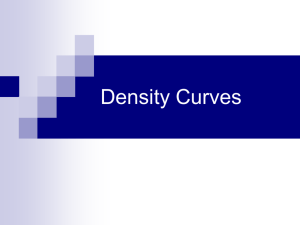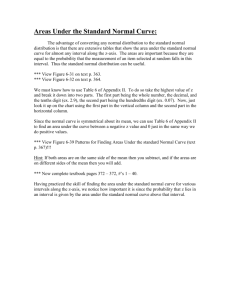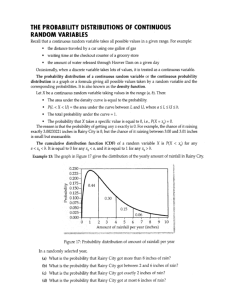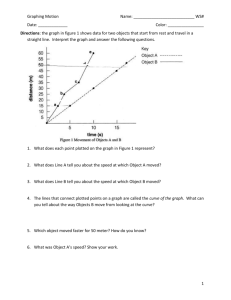Objective A : Area under the Standard Normal Distribution
advertisement
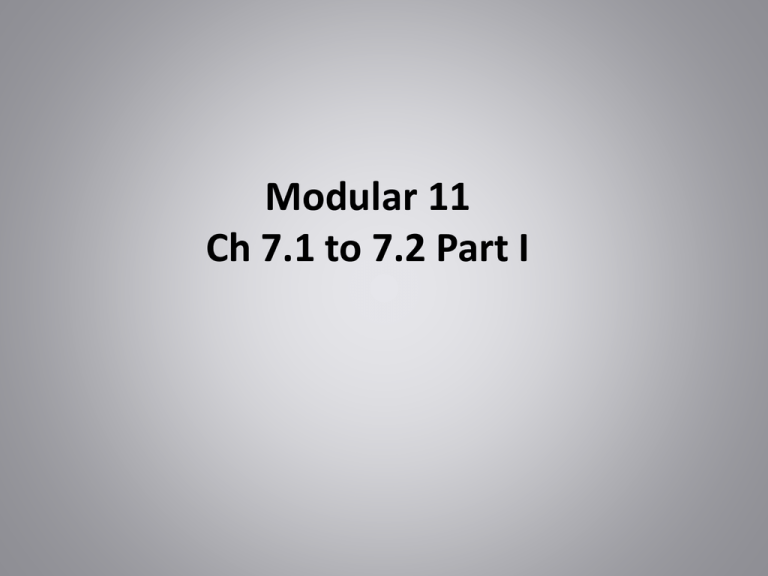
Modular 11 Ch 7.1 to 7.2 Part I Ch 7.1 Uniform and Normal Distribution Objective A : Uniform Distribution A1. Introduction Recall: Discrete random variable probability distribution Special case: Binomial distribution Finding the probability of obtaining asuccess in nindependent trials of a binomial experiment is calculated by plugging the value of a into the binomial formula as shown below : P( x a) n Ca p a (1 p) n a Continuous Random variable For a continued random variable the probability of observing one particular value is zero. i.e. P( x a ) 0 Continuous Probability Distribution We can only compute probability over an interval of values. Since P( x a) 0 and P ( x b) 0 for a continuous random variable, P ( a x b) P ( a x b) To find probabilities for continuous random variables, we use probability density functions. Two common types of continuous random variable probability distribution : • Uniform distribution • Normal distribution. Ch 7.1 Uniform and Normal Distribution Objective A : Uniform Distribution A2. Uniform Distribution 1 ba a b Note : The area under a probability density function is 1. Area of rectangle = Height x Width 1 = Height x (b a ) 1 Height = (b a) for a uniform distribution Example 1 : A continuous random variable x is uniformly distributed with 10 x 50 . (a) Draw a graph of the uniform density function. 1 40 10 50 Area of rectangle = Height x Width 1 = Height x (b a ) 1 Height = (b a) 1 1 = (50 10) 40 (b) What is P(20 x 30) ? Area of rectangle = Height x Width 1 40 20 30 1 x (30 20) 40 1 x 10 40 1 0.25 4 (c) What is P( x 15) ? P( x 15) P( x 15) P(10 x 15) Area of rectangle = Height x Width 1 x5 40 1 0.125 8 1 40 10 15 1 x (15 10) 40 Ch 7.1 Uniform and Normal Distribution Objective A : Uniform Distribution Objective B : Normal distribution Ch 7.2 Applications of the Normal Distribution Objective A : Area under the Standard Normal Distribution Ch 7.1 Uniform and Normal Distribution Objective B : Normal distribution – Bell-shaped Curve Example 1: Graph of a normal curve is given. Use the graph to identify the value of and . 2 2 1 1 X 330 430 530 630 730 530 100 Example 2: The lives of refrigerator are normally distributed with mean 14 years and standard deviation 2.5 years. (a) Draw a normal curve and the parameters labeled. 3 2 1 1 2 3 6.5 9 11.5 14 16.5 19 21.5 X (b) Shade the region that represents the proportion of refrigerator that lasts for more than 17 years. 17 6.5 9 11.5 14 16.5 19 21.5 X (c) Suppose the area under the normal curve to the right x = 17 is 0.1151. Provide two interpretations of this result. Notation: P( x 17) 0.1151 The area under the normal curve for any interval of values of the random variable x represent either: – the proportions of the population with the characteristic described by the interval of values. 11.51% of all refrigerators are kept for at least 17 years. – the probability that a randomly selected individual from the population will have the characteristic described by the interval of values. The probability that a randomly selected refrigerator will be kept for at least 17 years is 11.51%. Ch 7.1 Uniform and Normal Distribution Objective A : Uniform Distribution Objective B : Normal distribution Ch 7.2 Applications of the Normal Distribution Objective A : Area under the Standard Normal Distribution Ch 7.2 Applications of the Normal Distribution Objective A : Area under the Standard Normal Distribution The standard normal distribution – Bell shaped curve – 0 and 1 . 1 3.5 2 0 1 0 1 Negative Z 2 3.5 Z Positive Z The random variable for the standard normal distribution is Z . Use the Z table (Table V) to find the area under the standard normal distribution. Each value in the body of the table is a cumulative area from the left up to a specific Z score. Probability is the area under the curve over an interval. The total area under the normal curve is 1. Z 0 Z Under the standard normal distribution, (a) what is the area to the right of 0 ? 0.5 (b) what is the area to the left of 0 ? 0.5 Example 1 : Determine the area under the standard normal curve. (a) that lies to the left of -1.38. From Table V 0.08 0.0838 1.3 1.38 Z 0 0.0838 P( Z 1.38) 0.0838 (b) that lies to the right of 0.56. Table V only provides area to the left of Z = 0.56. 0.5 0.7123 1 From Table V 0.06 0.7123 Area under the whole standard normal distribution is 1. 0 0.56 Z P( Z 0.56) 1 0.7123 0.2877 (c) that lies in between 1.85 and 2.47. 0.9678 0.9932 0 1.85 2.47 Z From Table V 2.47 0.9932 1.85 0.9678 P(1.85 Z 2.47) 0.9932 0.9678 0.0254

